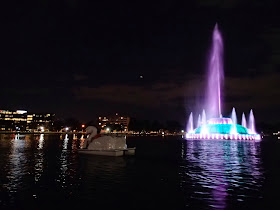 |
| Just above Homosassa Springs State Park |
Homosassa River is another bay/river/spring which has been carved into canals creating thousands of waterfront lots. But there are still large stretches of undeveloped land along the water.
Riversport Kayak is a great place to rent kayaks to explore that water.
Riversport Kayak is located inside the Homosassa Riverside Resort and is right on a canal, with its own launch site. Bring your own kayak and you can launch there for free. Mark rented a Wilderness Systems Pungo 140 and I rented a Wilderness Systems Tsunami 145.
Canals and river branches all tend to look similar, but there is a great landmark for the Homosassa Riverside Resort canal - Monkey Island. Monkey Island started life as a pile of rocks which occasionally gave unsuspecting boaters an unpleasant experience. In the 1960's the pile was built up to make it more visible. Mr. Furgason, a local developer, added a lighthouse to the barren island. Later, he decided it would be the perfect home for his monkeys.
Apparently, Mr. Furgason kept monkeys on some of his land as an attraction, but they were often in trouble, escaping and attacking tourists. Originally, he moved three spider monkeys and two squirrel monkeys to the island. Those monkeys have long since gone to their final reward, and the island is currently the residence of five spider monkeys. Their fear of water keeps them confined to the island.
Every time I pass by Monkey Island I'm amazed that the monkeys remain there. Look how close those keep-away buoys are to the island. And the cedar trees have branches that lean out over the water. It seems like it would be an overwhelming temptation for a spider monkey to leap from the tree to a passing boat, but I guess they don't and no boat ever gets too close. ( I never test the theory, because having a terrified toothed creature on a kayak with me seems like a pretty bad idea, but surely someone else is more foolish than me...)
Anyway further along the river, by a tiny canal, is a sign for Manatee Pub. It's nice to see that the manatees have a quiet place to gather.
And just a few miles up river from Monkey Island is the outlet from Homosassa Spring, which comes directly from
Homosassa Springs State Wildlife Park. There, in the warm out-flowing water, wild manatee gather. Overseeing them and protecting them are a crew of volunteer monitors in kayaks. On the day we were there, about a dozen manatee stretched across the river - guarded by three alert volunteers in kayaks who approached us and instructed us on good manatee etiquette.
 |
| A collection of manatee outside the park |
Homosassa Springs State Wildlife Park is a really sweet park containing a small zoo with only native Florida wildlife, (including a hippopotamus, who was declared an honorary Florida native.) It hosts the biggest manatees you've ever seen, flocks of birds, an aviary, and much more. And it's a great place to get wildlife closeups.
The park attracts flocks of volunteers, some of whom work in the gift store, or at the education center, and others who sit in their kayaks and make sure wild manatee are not disturbed.
We talked to several kayak volunteers; watched as one scooped up garbage flowing by ("Bud fish," he called them), learned one was from Mark's hometown, but did we take any pictures? I guess not.
The outlet from the state park spring is fenced off, but the river continues on a short way, under a bridge and into a quiet neighborhood. That's where we spotted this alligator snapper, nicely outlined against the algae.
We also followed a few canals along the trip, exploring these quiet passages.
Then it was back to talk to Don at Riversports.
 |
| Don |
If you enjoy tales of wildlife, Don is great person to talk with. When we arrived he was chasing vultures away from a trash bin, which had accidentally been left open. He chased the big birds off, not because they were unsightly, but because things in the bin, like plastic with food on it, injure the birds. Don helps with the care of the monkeys on Monkey island - he mans the squirt guns which keep the monkeys under control when the veterinarian visits. He has an armadillo named Tank who lives under his porch and has had adventures with almost every type of animal in Florida. And for good measure, his wife helps with the bears at the wildlife state park.



















































